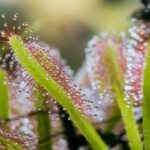As an Amazon Associate, this site earns commissions from qualifying purchases. For more details, click here.
Sundews are carnivorous plants that often try to eat whatever bug gets caught in their trap, and that includes aphids. However, aphids (greenflies) might also cause a few problems so you need to keep an eye on things if there are many of these around your plant.
Sundews trap and eat small bugs like flies, spiders and even aphids. These insects contain nutrients such as nitrogen that sundews use to produce dew and to develop resistance to infection.
How to Feed Aphids to Sundews
There are many ways to feed sundews. If the plant is outdoors and regularly catches aphids and other bugs, there is no need to give it any food. Just let the plant catch bugs on its own otherwise you run the risk of overfeeding. For indoor sundews, just drop the aphid into the sticky stuff. Sundews will eat living and dead aphids, and you do not need to stimulate the tentacle either.
When an aphid lands in the mucilage (the dew or sticky substance), the sundews will secrete digestive enzymes to consume it.
Sundews can only feed on small bugs. If you want to feed a larger than usual aphid, cut it into small bits before dropping it into the dew.
This rule applies to any food you will give sundews. The plant will try to eat any prey it catches, but if it is too large the leaf will burn and die. So whether the prey is an aphid or something else, make sure it is small enough to be digested.
You should only feed sundews if there is dew on its tentacles. The sticky substance is required for feeding and misting with water will not do any good.
If your sundew does not have dew, it means the plant is not healthy. There are many possible reasons such as insufficient light, low humidity and polluted water. There are also solutions for this.
Get your sundew healthy before feeding it. 8 to 12 hours of sunlight is the usual method, though lighting such as Spider Farmer Grow Lights works too. Use only rainwater, reverse osmosis or purified water. When the plant starts producing dew, you can feed it aphids as instructed above.
How Many Aphids Can a Sundew Eat?
Sundews only need to eat one insect a week. Larger, more mature plants will be fine with only 1 or 2 bugs a month.
Sundews do not need a lot of insects because they already have a food source, the sun. Just like other plants, sundews use photosynthesis to generate glucose. This substance provides plants with the energy they need for daily activities.
Typically sundews take 15 minutes to kill an aphid with its enzymes. However, digestion might take seven days. Assuming it takes a week to digest an aphid, you can see why the plant can only eat one bug a week.
Can you feed several aphids at once? Yes, but if you give it four bugs today, the subsequent feeding time has to be next month.
Sundews do not have enough energy to eat several insects continuously, no matter how small they are. As a grower, you just have to make certain the plant receives the proper amount of nutrition. In this case all it takes is 1-4 insects every four weeks.
Why Do Sundews Eat Aphids?
Insects like aphids are rich in nutrients, something sundews need. Carnivorous plants like sundews and Venus flytraps do not eat bugs for food, but nutrition.
All plants require food and nutrition and sundews are no exception. Glucose is their food which they acquire through photosynthesis. Most plants obtain nitrogen and other elements from the soil but carnivorous plants only grow in nutrition free dirt, so they acquire nutrients from insects and other small prey.
How Sundews Eat Insects
Whether it is an aphid, spider, fly or any other prey, sundews use the same method to eat it. The process starts by luring the insect.
The tentacles of a drosera is covered with a sticky dew-like substance called mucilage. It has a sweet smell that insects are drawn to.
When an aphid lands on the mucilage, it immediately gets stuck. Think of how flypaper works and you get an idea of how its trapping mechanism functions.
The more the aphid tries to escape, the more it gets stuck. The other tentacles will suffocate the insect until it is secured.
Once the aphid is held down or dead, the plant secretes enzymes which dissolve its tissues. Both the bug and the enzymes are absorbed by the plant. Thanks to this method, carnivorous plants do not require rich soil. In fact that will do more harm than good, so use only poor soil for sundews.
Can Aphids Harm Sundews?
While sundews eat aphids, these insects can cause an infestation and kill the plant. These bugs can also carry diseases, but fortunately there are ways to prevent this.
Aphids are distinguishable by their green color, but yellow, black, gray and brown variants also exist. If you see these around your sundew, isolate the plant from the rest. Use an insect repentant like Mighty Mint Insect Spray to eliminate aphids and other pests.
Signs of Aphid Infestation in Sundews
First you need to check if there are any aphids. If you have a good eye you can probably spot them. But there are other telltale indicators.
- Galls on sundew roots and leaves. This is a common sign leaf behind by aphids.
- Sundew flowers are deformed. If you let sundews flower and notice they are out of shape, it could be due to aphids eating them.
- Blackened leaves and branches. Aphid honeydew can result in sooty mold which causes the leaves and roots to wither and die.
- Deformed, yellowish leaves. If the leaves are deformed, damaged, curled or altered in any way, it is probably due to the aphids.
If one drosera is infected you have to isolate it as there is a strong possibility that the infestation will reach the other plants. This is why prevention and quick elimination of aphids is recommended.
How to Remove Aphids From Sundews
Once you have determined aphids are infesting your sundews, there are several methods you can use to get rid of them.
- Hose with water. Pour cold water over the infested parts. The colder the water the better.
- Use an insecticide spray. Use a quality spray that eliminates aphids but will not harm your sundews. Follow the instructions before using it. Read the label first and use it only if your plant is listed there.
- Place the plant in water. Submerge the infested parts for a few seconds. This method works best if there are only a few aphids.
How to Protect Sundews From Aphids
- Keep natural predators around. Spiders, ladybugs, hornets, soldier beetles, yellow jackets and big eyed bugs all feed on aphids. They will keep those pests at bay. But if you see several of these in your garden, it could also be a sign aphids are widespread.
- Watch out for aphids early. They usually spread in late spring, so keep an eye out. They also like to come out during hot summer days.
- Check other plants for aphids. These insects prefer asters, cosmos, dahlias and zinnias among others. If you have any of these, aphids could be present and spread to your sundews.
- Watch for ants. Ants herd aphids for their honeydew, so if you see several it could mean aphids are in the vicinity.
- Aphids hate chive, onions and garlic. Plant these in your garden and it should keep aphids away from your sundews.
If you only see an occasional aphid on your sundews, it is not an issue. The plant will have no problem digesting it. However if you see several on your sundew or any of your other plants, remove them at once.
Conclusion
The bottom line is sundews can and do eat aphids. However, these bugs can cause severe damage if not taken care of. As long as you monitor for signs of infestation, this can be prevented and nipped right in the bud.

My fascination with carnivorous plants began many, many years ago with Venus Fly Traps. Now I am more than happy to impart what I know with other enthusiasts and those who are curious about meat eating plants.



